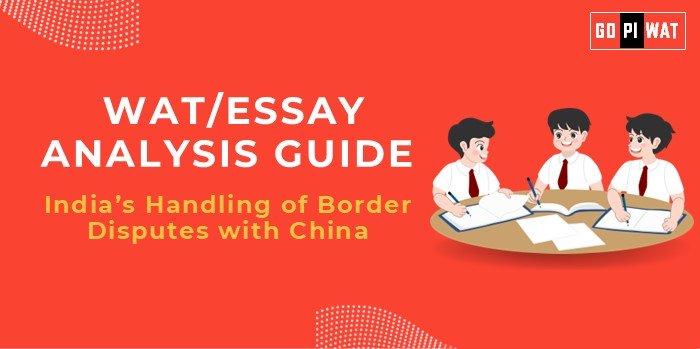📋 Written Ability Test (WAT) / Essay Analysis Guide
🌐 Understanding the Topic’s Importance
The India-China border issue reflects the complexities of geopolitical conflicts, involving diplomacy, economics, and defense strategies. For B-school students, it offers insights into negotiation, conflict resolution, and strategic planning.
📝 Effective Planning and Writing
- Time Allocation:
- 🕒 Planning: 5 minutes
- 🖊️ Writing: 20 minutes
- 🔍 Reviewing: 5 minutes
- Preparation Tips:
- 📊 Include statistics (e.g., 3,488 km border, trade value of $135.98 billion).
- 🗓️ Reference incidents like Galwan or Doklam for examples.
💡 Introduction Techniques for Essays
- Contrast Approach: “India’s ethos of peaceful coexistence faces a unique challenge in dealing with China’s assertive border policies, a dichotomy underscored by the 2020 Galwan Valley incident.”
- Timeline Approach: “From the 1962 war to the 2020 Galwan clash, the India-China border dispute has been characterized by periods of uneasy peace and sharp conflict.”
🛠️ Structuring the Essay Body
- Achievements: Highlight infrastructure development and strategic partnerships.
- Challenges: Discuss issues like LAC ambiguity and economic dependency.
- Future Outlook: Suggest measures such as clearer LAC definitions, leveraging global forums, and continued infrastructure upgrades.
📊 Analyzing Successes and Shortcomings
🎯 Key Successes
- 🤝 Diplomatic Mechanisms Established: Agreements like the 1993 “Peace and Tranquility Agreement” have largely averted large-scale conflict and established dialogue frameworks.
- 🚧 Infrastructure Advancements: India’s border infrastructure, like the Darbuk-Shyok-DBO Road, has improved logistical capabilities.
- 🌏 Strengthened Global Alliances: Partnerships with the QUAD countries (US, Japan, Australia) and organizations like ASEAN have boosted India’s strategic leverage.
- 💪 Resilience and Strategic Patience: India has balanced its approach, avoiding escalation despite provocations like the Galwan Valley clash.
⚠️ Ongoing Shortcomings
- ❓ LAC Ambiguity: The undefined Line of Actual Control leads to frequent disputes and misunderstandings.
- 📈 Economic Dependency on China: Bilateral trade, worth $135.98 billion in 2022, reflects India’s reliance on Chinese imports, particularly electronics and pharmaceuticals.
- ⚖️ Asymmetric Power Dynamics: China’s military and economic dominance limits India’s counter-pressure capabilities.
- 🤷♂️ Limited Regional Consensus: Neutral or pro-China stances by neighboring countries reduce regional support for India.
🔑 Recommendations for Sustainable Progress
- Enhance Border Infrastructure:
- 🚧 Accelerate construction of roads, railways, and airstrips to match China’s developments.
- 📡 Deploy advanced surveillance systems like drones and satellite imaging.
- Define the LAC Clearly:
- ✍️ Work towards mutually agreed LAC demarcation through bilateral talks.
- 🌍 Leverage international forums, such as the UN, for third-party arbitration if needed.
- Reduce Economic Dependency:
- 🇮🇳 Promote “Atmanirbhar Bharat” to diversify supply chains and reduce reliance on Chinese imports.
- 🤝 Strengthen trade agreements with ASEAN and EU countries.
- Foster Regional Partnerships:
- 🌟 Build alliances with neighbors like Nepal, Bhutan, and Bangladesh to counter China’s influence.
- 📢 Expand cooperation under platforms like BIMSTEC and SAARC.
- Strengthen Military Readiness:
- 🛡️ Increase defense spending for modernizing high-altitude warfare equipment.
- 🤝 Conduct joint military exercises with allies to enhance interoperability.
- Engage the Global Community:
- 🌐 Use platforms like G20 and BRICS to emphasize peaceful resolutions and expose aggressive posturing.
- 💬 Encourage global mediation similar to other conflict zones like Israel-Palestine.
- Invest in Soft Power:
- 🎨 Promote India’s peaceful stance via cultural and diplomatic outreach.
- 📰 Highlight resilience and expose aggression through strategic media campaigns.
📄 Concluding Effectively
- ⚖️ Balanced Conclusion: “India’s diplomatic and military handling of its border disputes with China has shown both resilience and limitations. Future efforts must focus on fostering clarity and ensuring sustainable peace.”
- 🌍 Global Comparison Conclusion: “India’s approach contrasts with Taiwan’s or Ukraine’s, emphasizing diplomacy and restraint, but it also reveals gaps that need addressing for long-term stability.”
📚 Sample Short Essays
- 📋 Balanced Perspective: “India’s handling of border disputes with China showcases a mix of success and limitations. Strategic infrastructure and alliances bolster India’s position, but recurring clashes underscore the challenges of achieving lasting peace.”
- 🔍 Solution-Oriented: “India must focus on multilateral diplomacy and local infrastructure development to manage China’s provocations effectively. Lessons from global conflicts highlight the need for preventive measures.”
- 🌏 Global Comparison: “India’s strategy in managing border disputes with China contrasts with Taiwan’s approach to Chinese assertiveness, demonstrating the importance of balancing military readiness with global alliances.”


